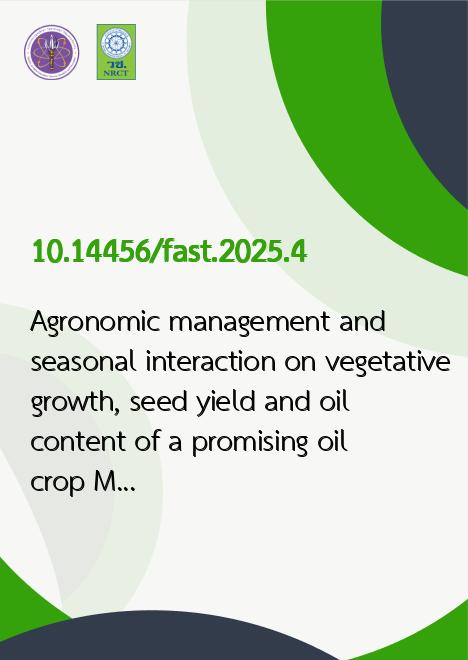
|
Agronomic management and seasonal interaction on vegetative growth, seed yield and oil content of a promising oil crop Monechma ciliatum |
|---|---|
| รหัสดีโอไอ | |
| Creator | Basheir Elagib Elradi Babikir |
| Title | Agronomic management and seasonal interaction on vegetative growth, seed yield and oil content of a promising oil crop Monechma ciliatum |
| Contributor | Shadia Abdelgadir Rayis, Abdalbasit Adam |
| Publisher | Mahasarakham University |
| Publication Year | 2568 |
| Journal Title | Food Agricultural Sciences and Technology (FAST) |
| Journal Vol. | 11 |
| Journal No. | 1 |
| Page no. | 35-44 |
| Keyword | Autumn, Summer, Monechma ciliatum, Spacing, Seed |
| URL Website | https://ph02.tci-thaijo.org/index.php/stej/index |
| Website title | Food Agricultural Sciences and Technology (FAST) |
| ISSN | 2822-1001 (Print), 2822-101X (Online) |
| Abstract | To assess the impact of agricultural techniques and determine genotype-season interaction on Monechma ciliatum, a field experiment was carried out over the course of two growing seasons (autumn and winter). In the Abu Naama environment, four sample seeds were seeded at four different times and with four different plant spacings (10, 20, 30, and 40 cm). The sample seeds were from separate sites. Plant height, leaves, branch count, population density, yield, oil content, and fresh and dry weight were all found to be impacted by the sowing date and plant spacing. Data was captured and subjected to statistical analysis. When compared to plants grown in the winter, autumn-grown plants produced higher plant spacing values. 1 The greatest values were obtained from plants spaced 40 cm apart, then 30 cm, 20 cm, and 10 cm. According to the yield-related sowing date effect, autumn was preferable to winter. Sowing dates were found to have a substantial (P?0.01) impact on oil content. Plants cultivated in the autumn had higher oil content values recorded, but plants grown in the winter had lower values. The oil content and fresh weight of the four sample seeds did not differ significantly. Seasons, spacing, and different seeds all displayed extremely significant (P?0.01) differences. |